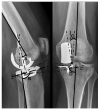Cementless Oxford Medial Unicompartmental Knee Replacement-Clinical and Radiological Results of 228 Knees with a Minimum 2-Year Follow-Up
- PMID: 32423118
- PMCID: PMC7290835
- DOI: 10.3390/jcm9051476
Cementless Oxford Medial Unicompartmental Knee Replacement-Clinical and Radiological Results of 228 Knees with a Minimum 2-Year Follow-Up
Abstract
(1) Background: Studies show several advantages of unicompartmental knee replacement (UKR) over total knee replacements (TKR), whereas registry based revision rates of UKR are significantly higher than for TKA. Registry data report lower revision rates for cementless UKR compared to cemented UKR. The aim of this study was to assess clinical and radiological results of cementless Oxford UKR (OUKR) in an independent cohort. (2) Methods: This retrospective cohort study examines a consecutive series of 228 cementless OUKR. Clinical outcome was measured using functional scores (Oxford Knee Score (OKS), American Knee Society Score (AKSS), Hannover Functional Ability Questionnaire for Osteoarthritis (FFbH-OA), range of motion (ROM)), pain and satisfaction. Radiographs were analyzed regarding the incidence of radiolucent lines (RL), implant positioning, and their possible impact on clinical outcome. (3) Results: At a mean follow-up of 37.1 months, the two and three year revision free survival-rates were 97.5% and 96.9%. Reasons for revision surgery were progression of osteoarthritis, inlay dislocation and pain. All clinical outcome scores showed a significant improvement from pre- to postoperative. The incidence of RL around the implant was highest within the first year postoperatively (36%), and decreased (5%) within the second year. Their presence was not correlated with inferior clinical outcome. Implant positioning showed no influence on clinical outcome. (4) Conclusion: Cementless OUKR showed excellent clinical outcome and survival rates, with reliable osteointegration. Neither the incidence of radiolucent lines nor implant positioning were associated with inferior clinical outcome.
Keywords: OUKR; Oxford medial; cementless UKR; cementless fixation; radiolucencies; radiolucent lines.
Conflict of interest statement
Author B.P. reports research funding from Zimmer Biomet, outside the submitted work. Authors M.M., T.R. and M.S. have no conflicts of interests to declare. Authors C.M. and T.G. report research funding and paid lectures from Zimmer Biomet outside the submitted work.
Figures




Similar articles
-
Clinical and Functional Results of Cementless Unicompartmental Knee Arthroplasty with a Minimum Follow Up of 5 Years-A Consecutive Cohort of 201 Patients.J Clin Med. 2023 Feb 20;12(4):1694. doi: 10.3390/jcm12041694. J Clin Med. 2023. PMID: 36836231 Free PMC article.
-
Cementless medial Oxford unicompartmental knee replacement. Five-year results from an independent series.Knee. 2020 Aug;27(4):1219-1227. doi: 10.1016/j.knee.2020.05.009. Epub 2020 Jun 26. Knee. 2020. PMID: 32711885
-
Cementless Oxford medial unicompartimental knee replacement: an independent series with a 5-year-follow-up.Arch Orthop Trauma Surg. 2017 Jul;137(7):1011-1017. doi: 10.1007/s00402-017-2696-9. Epub 2017 Apr 24. Arch Orthop Trauma Surg. 2017. PMID: 28439705
-
Medial Unicompartmental Osteoarthritis (MUO) of the Knee: Unicompartmental Knee Replacement (UKR) or Total Knee Replacement (TKR).Arch Bone Jt Surg. 2014 Sep;2(3):137-40. Epub 2014 Sep 15. Arch Bone Jt Surg. 2014. PMID: 25386571 Free PMC article. Review.
-
No difference between cemented and cementless total knee arthroplasty in young patients: a review of the evidence.Knee Surg Sports Traumatol Arthrosc. 2017 Jun;25(6):1749-1756. doi: 10.1007/s00167-017-4519-5. Epub 2017 Mar 22. Knee Surg Sports Traumatol Arthrosc. 2017. PMID: 28332044 Review.
Cited by
-
Risk factors for valgus subsidence in uncemented medial unicompartimental knee arthroplasty.Bone Jt Open. 2025 Feb 11;6(2):178-185. doi: 10.1302/2633-1462.62.BJO-2024-0161.R1. Bone Jt Open. 2025. PMID: 39929236 Free PMC article.
-
The association between surgeon grade and radiographic implant alignment following oxford unicompartmental knee replacement.Arch Orthop Trauma Surg. 2025 Jul 3;145(1):362. doi: 10.1007/s00402-025-05973-y. Arch Orthop Trauma Surg. 2025. PMID: 40608142 Free PMC article.
-
Clinical and Functional Results of Cementless Unicompartmental Knee Arthroplasty with a Minimum Follow Up of 5 Years-A Consecutive Cohort of 201 Patients.J Clin Med. 2023 Feb 20;12(4):1694. doi: 10.3390/jcm12041694. J Clin Med. 2023. PMID: 36836231 Free PMC article.
-
Mediating role of pain sensitization in preoperative and postoperative pain in knee osteoarthritis patients.Eur J Med Res. 2025 Apr 17;30(1):301. doi: 10.1186/s40001-025-02485-8. Eur J Med Res. 2025. PMID: 40247421 Free PMC article.
-
The Anterior Impingement After Mobile-Bearing Unicomparimental Knee Arthroplasty-A Neglected Problem. A Clinical Report of 14 Cases.Arthroplast Today. 2022 Aug 19;17:94-100. doi: 10.1016/j.artd.2022.06.019. eCollection 2022 Oct. Arthroplast Today. 2022. PMID: 36042942 Free PMC article.
References
-
- Green M., Howard P., Porter M., Wilkinson M., Wishart N., National Joint Registry for England Wales Northern Ireland and the Isle of Man National Joint Registry for England, Wales, Northern Ireland and the Isle of Man: 14th Annual Report 2017. [(accessed on 17 July 2018)]; Available online: http://www.njrreports.org.uk/Portals/0/PDFdownloads/NJR%2014th%20Annual%....
-
- The New Zealand Orthopaedic Association The New Zealand Joint Registry―Nineteen Year Report January 1999 to December 2017, 2018. [(accessed on 26 April 2019)]; Available online: https://nzoa.org.nz/system/files/DH8152_NZJR_2018_Report_v6_4Decv18.pdf.
LinkOut - more resources
Full Text Sources

